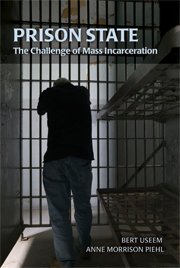Book contents
- Frontmatter
- Contents
- Acknowledgments
- 1 The Buildup to Mass Incarceration
- 2 Causes of the Prison Buildup
- 3 More Prison, Less Crime?
- 4 Prison Buildup and Disorder
- 5 The Buildup and Inmate Release
- 6 Impact of the Buildup on the Labor Market
- 7 Conclusion: Right-Sizing Prison
- Notes
- Index
- CAMBRIDGE STUDIES IN CRIMINOLOGY
7 - Conclusion: Right-Sizing Prison
Published online by Cambridge University Press: 31 January 2011
- Frontmatter
- Contents
- Acknowledgments
- 1 The Buildup to Mass Incarceration
- 2 Causes of the Prison Buildup
- 3 More Prison, Less Crime?
- 4 Prison Buildup and Disorder
- 5 The Buildup and Inmate Release
- 6 Impact of the Buildup on the Labor Market
- 7 Conclusion: Right-Sizing Prison
- Notes
- Index
- CAMBRIDGE STUDIES IN CRIMINOLOGY
Summary
Sanctions, penalties, and the fear of punishment are merely braces and not foundations.
The dominant competitive weapon of the twenty-first century will be the education and skills of the workforce.
The prison buildup movement, we have argued, was a pragmatic effort to deal with an escalating crime rate rather than, as the critics claimed, an irrational expression of a disturbed population or an effort to achieve an otherwise extraneous political agenda. The critics include David Garland and Loïc Wacquant, in a tradition that springs from the work of Michel Foucault. These attributions of irrationality, we found, do not fit the available facts. Yet, more generally, although social movements are pragmatic efforts to create new social forms, they are not deliberative bodies or research seminars. They do not collect evidence on the structures that they are seeking to bring, or have brought, into being. Data analysis (with all its complications) is not part of their “repertoire” for contention. Social movements are rational, but they are not hyperrational. If successful in achieving their immediate goals, they may not know how, or even when, to stop. More prisons, even if effective up to a point, may have exceeded that point during the buildup, as well as damaged society in other ways. The prison buildup movement may have unknowingly gone too far. Although social movements are strong in their mechanisms of mobilization, they have weak brakes.
- Type
- Chapter
- Information
- Prison StateThe Challenge of Mass Incarceration, pp. 169 - 180Publisher: Cambridge University PressPrint publication year: 2008

